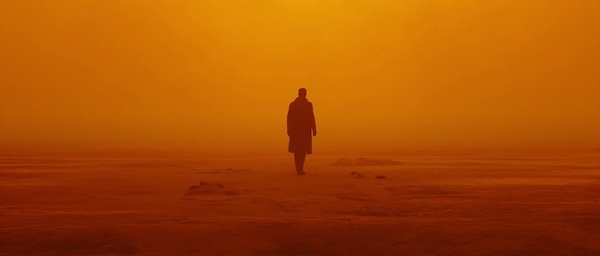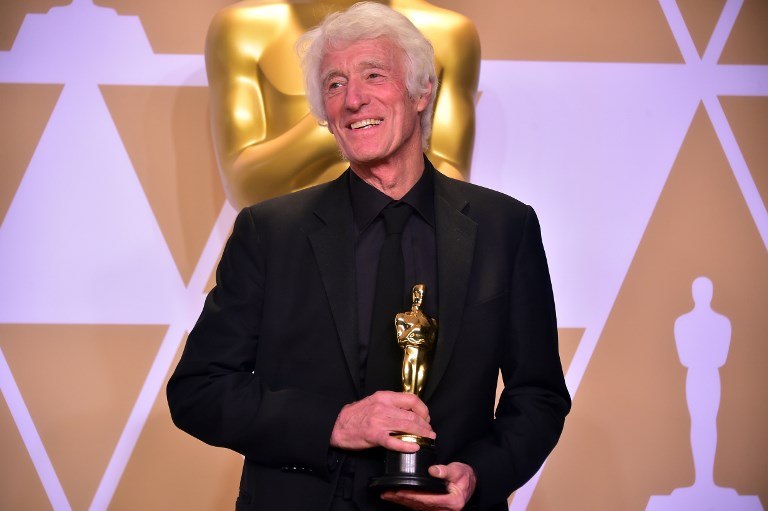Podcast Review: “Team Deakins” — For Film Geeks Only (and That’s not a Bad Thing)
By Neil Giordano
The podcast Team Deakins has quite a bit to teach us about the art and craft of cinematography.
Team Deakins can be found at all podcast venues, including Apple and Spotify, and at rogerdeakins.com. Listeners can submit questions for discussion in future episodes.

A Roger Deakins image from Blade Runner 2049.
In these strange days when many are losing track of the days of the week, the search is on for new intellectual and creative outlets. Even those in the moviemaking business are in the same boat. Hollywood is shut down. Thankfully, we’re blessed that one of unemployed who has decided to make something of his time is the celebrated cinematographer Roger Deakins and his wife and creative partner James Deakins. Team Deakins reflects back on their respective careers and their thirty-plus year creative collaboration. Highly listenable and abundantly informative, the Team has plenty to offer cinephiles in need of a thoughtful film fix.
You may not know Roger Deakins by name, but chances are you are familiar with his work. He is one of the most accomplished film artisans of the last 40 years. He started out in his native England, shooting television, documentaries, and music films, and then transitioned into narrative films full-time by the mid-’80s. His breakthrough movies are 1984 and Sid and Nancy. In 1990 the Coen Brothers lured him across the pond for Barton Fink, and his collaboration with them continues to this day, spanning from Fargo and No Country For Old Men to Hail Caesar! His impressively varied résumé includes such popular favorites as The Shawshank Redemption, Martin Scorsese’s breathtakingly beautiful and criminally underseen Kundun, and the most arty of James Bond films, Skyfall. In 2018, Deakins earned his first of two Oscars (after a notorious 24-year stretch of nominations without wins) for Blade Runner 2049 and 1917, both of which display the range of his technical and artistic ability: Blade Runner for its dreamy and unreal color palettes, 1917 for its fidelity to maintaining the conceit of a nonstop 100-minute tracking shot.
James Deakins works further behind the scenes, now as Roger’s most trusted associate. She is a highly skilled problem solver who knows the ins and outs of cameras, digital workflow, and, most importantly, how to get stuff done on a film set efficiently while surrounded by big egos and even bigger power players. Not surprisingly, she began her career as a script supervisor, an unheralded but indispensable job on a film set that is plugged into continuity issues as well as the organization of shooting.

Roger Deakins: After 23 years and 14 nominations! 90th Academy Awards, March 4th 2018. Photo: Facebook.
Now at 10 episodes and climbing, Team Deakins leans heavily on giving listeners an insiders’ view of the filmmaking process. The podcast covers a lot of ground: it is a primer on how to get into the business, a detailed memoir of visualizing film space, and a highly technical discourse on lighting, composition, and any number of other photographic techniques that go into making a film look beautiful while also advancing its storyline.
In short, the podcast is a film geek’s treasure trove. If one looks at filmmaking as a series of choices, Team Deakins affirms that in spades, with Roger walking through the hypotheticals he asks and answers for each scene or individual shot: Where do you put the camera and what happens if you move it a few inches to the side? When and how do you use available light? What would change if you switch out to a slightly longer lens?
If you’re not familiar with the language of cinematography, you might feel left out at times. But, for hands-on people like me, it’s ear candy. You are given a privileged glimpse at the layout of film sets, insights into the ways that Deakins captured some of his most famous scenes, and even a little behind-the-scenes dish about Hollywood actors and directors. Sprinkling their conversation with references to films they made over the past three decades, the pair single out particular shots and then dive in, with descriptive flair, to dissect the frame’s technical, visual, and, most importantly, emotional content. Listeners are invited to conjure up those images: a silhouette of a figure against a window, the glowing orange of a fire in an otherwise grey field, a couple in a dimly lit romantic restaurant. More than a few times, I made a note to myself to track down a few scenes for a rewatch.
At times, however, the podcast ventures into technical jargon to the point of no return, even for a film buff. Perhaps there is a segment of listeners who dream of becoming future filmmakers. Who want to learn the nuts and bolts of camera and lighting techniques. But really, unless you want to become a cinematographer, you are bound to become impatient when hearing, at great length, about the intricacies of using triple-wick candles to increase the luminage in medium-length camera shots in a dimly lit barn in the south of England on a grey afternoon when the light is fading. An episode with film lab wizard Beverly Wood as special guest turned into a discourse on chemistry, film stocks, and silver retention, brilliant in its own right, but you wouldn’t be blamed for wanting to fast forward to another episode. Team Deakins are many things, but they are not editors.

A Roger Deakins image from The Hudsucker Proxy.
Nonetheless, the banter between the husband and wife creative team is delightful and engaging in most episodes. As any marital partners can do, they speak of shared memories, the details of a moment long ago they both can pinpoint (“like the one time in that scene from Hudsucker Proxy when….” “oh yes, right, right, that one…”). James takes on the role of interviewer, guiding the conversation via a mellifluous voice worthy of NPR. Thankfully, they are also assisted by another member of the “team,” Matt Wyman, an aspiring cinematographer and Deakins acolyte. He’s not quite a third wheel so much as a focusing mechanism (no pun intended). He grounds their memories in the subject at hand, and takes an objective view of their recollections, keeping them germane to the discussion. His youth also counters their experience. In fact, Wyman acts as a bridge to our digital age; he has never shot on actual film, whereas the Deakins duo speak fluently about both the celluloid days and the transition to digital (the subject of more than one episode).
The highlights of the first run of episodes are supplied by Roger himself. He brings his origins in street photography and documentary film to life through articulately recounted memories and anecdotes. He lauds the opportunity he was granted by Britain’s publicly funded National Film School in the ’70s. At least on the podcast, Roger has nothing but kind words for everyone he’s ever worked with (he has a reputation as one of the nicest people in the business). Roger speaks humbly but also confidently about making use of a collaborative style on film sets, and proudly points out that he still acts as a camera operator on his films, a rarity among cinematographers.
Elsewhere, Roger speaks animatedly about how light changes minute to minute on a location shoot, or of the ways that, if manipulated properly, the texture of light can be used to alter our perceptions of a character or a scene. At the end of one episode, he looks across the room in which he’s sitting, notices the sunlight emerging through the rainy afternoon on the window frame, and talks about how he might shoot it in any number of ways to create a different effect each time. At another time he advises, “You can have a formula, but that’s not necessarily satisfying . . . I mean, what are you doing it for? . . . I’m doing it because I like playing with images, and I like seeing the effect an image has on the story.”
That’s cinematography in a nutshell, and Team Deakins has quite a bit to teach us about the art and craft.
Neil Giordano teaches film and creative writing in Newton. His work as an editor, writer, and photographer has appeared in Harper’s, Newsday, Literal Mind, and other publications. Giordano previously was on the original editorial staff of DoubleTake magazine and taught at the Center for Documentary Studies at Duke University.
